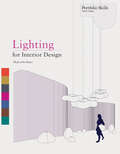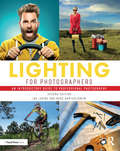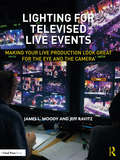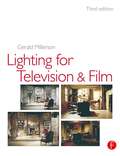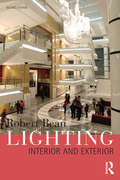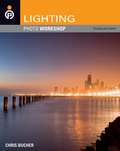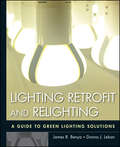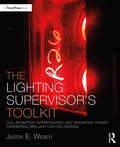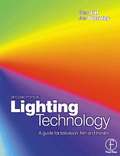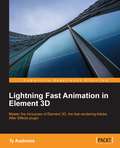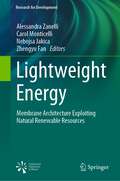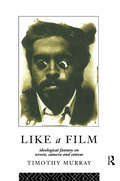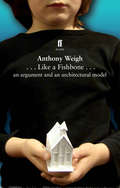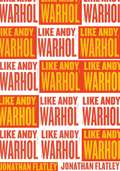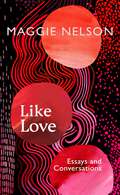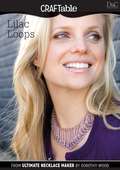- Table View
- List View
Lighting for Interior Design (Portfolio Skills)
by Malcolm InnesWithout light, interior architecture cannot be fully designed and experienced. It is one of the key tools for an interior designer, but can be a dauntingly technical subject for students.Part One, Theory, looks at the physics and technology behind lighting. Part Two, Process and Practice, looks more specifically at the use of lighting in interior design and outlines the key design issues and principles. The book goes on to show the ways of representing lighting schemes using CAD and 3D models and how to implement and test these designs. Finally, the book explains how to deal with contractors, clients and other professionals.This book takes a detailed, practical look at lighting in interior design, giving students all the key information and skills they need to be able to tackle lighting successfully in their designs.
Lighting for Photographers: An Introductory Guide to Professional Photography
by Joseph Lavine Brad BartholomewLighting is one of the most important aspects of any photograph. The best images create dimension and drama, which goes beyond formulas and lighting recipes. In Lighting for Photographers: An Introductory Guide to Professional Photography, commercial photographers and instructors Joe Lavine and Brad Bartholomew offer a unique philosophy of lighting, starting with an understanding of the characteristics of lighting to build great shots.Including interviews from professional photographers and illustrated with over 200 images, this book introduces basic photographic concepts and equipment needs, and takes the reader from the lighting process through to starting a successful career in photography both in the studio and on location. Readers will learn a comprehensive approach to lighting including what light does, composition, experimentation, practical tools and techniques, equipment, metering and histograms, and how to launch and grow their career.With downloadable instructor resources featuring discussion questions and quizzes, this fully updated edition is ideal for introductory level photography and lighting courses as well as the amateur photographer looking to apply the appropriate lighting to realize their conceptual and aesthetic goals.
Lighting for Televised Live Events: Making Your Live Production Look Great for the Eye and the Camera
by James L. Moody Jeff RavitzLighting for Televised Live Events unlocks the science, art, philosophies, and language of creating lighting for live entertainment and presentations that work for the television camera as well as for the live audience. The book explores how to retain the essence and excitement of a live production while assuring that the show looks its best on-camera for the millions of viewers that can only see it on their TV, computer, tablet, or mobile phone screen. Readers will learn how to adapt an existing stage show for the camera, as well as how to design live entertainment or events specifically for TV. Filled with real-life examples and illustrations, the book covers a wide range of topics, including: how exposure and color work for the camera; how angle, visual balance, and composition can make people and backgrounds look their best, while preserving theatricality; information on camera equipment, screens, and projectors, as well as the control room environments that are found on a professional shoot; the unique challenges of lighting for the IMAG video screens used at festivals and concerts. Lighting for Televised Live Events is aimed at lighting design students, as well as professional designers that are considering a career — or a career expansion — in television. It is an essential resource for any stage lighting designer whose show may be shot for a television special or a live webcast and who will be asked by their client to collaborate with the incoming video team.
Lighting for Televised Live Events: Making Your Live Production Look Great for the Eye and the Camera
by James L. Moody Jeff RavitzLighting for Televised Live Events unlocks the science, art, philosophies, and language of creating lighting for live entertainment and presentations that work for the television camera as well as for the live audience. The book explores how to retain the essence and excitement of a live production while assuring that the show looks its best on-camera for the millions of viewers that can only see it on their TV, computer, tablet, or mobile phone screen. Readers will learn how to adapt an existing stage show for the camera, as well as how to design live entertainment or events specifically for TV. Filled with real-life examples and illustrations, the book covers a wide range of topics, including: how exposure and color work for the camera; how angle, visual balance, and composition can make people and backgrounds look their best, while preserving theatricality; information on camera equipment, screens, and projectors, as well as the control room environments that are found on a professional shoot; the unique challenges of lighting for the IMAG video screens used at festivals and concerts. Lighting for Televised Live Events is aimed at lighting design students, as well as professional designers that are considering a career — or a career expansion — in television. It is an essential resource for any stage lighting designer whose show may be shot for a television special or a live webcast and who will be asked by their client to collaborate with the incoming video team.
Lighting for TV and Film
by Gerald MillersonSkilful lighting involves a subtle blend of systematic mechanics and a sensitive visual imagination. It requires anticipation, perceptiveness, patience and know-how. But learning through practice alone can take a great deal of time. This book is a distillation of many years' experience, with advice and guidance that will bring successful results right from the start. Whether you are a student studying lighting techniques in the television, video and film media, or a professional lighting for the camera, this book will be an invaluable aid. Other members of the production team, including camera crews, designers and directors, will also find the information here interesting and useful.The book concentrates primarily on the fundamental principles of lighting in studios, on location and display, as well as single-camera, small unit production, improvised and economy lighting, and working with limited facilities. Emphasis is also placed on the safety aspects of working with lighting equipment.Lighting for Television and Film reflects the author's considerable experience of lighting techniques in BBC studios, his teaching and consultancy work.Gerald Millerson's analytical writings spring from a lifetime's personal experience in the medium, and from his teaching and engineering background. During his career with the BBC, he was primarily associated with studio operations in the Television Service. His lecturing background included courses in TV production at a number of American universities.His other books for Focal Press are Television Production, TV Scenic Design, Video Production Handbook and, in the Media Manuals series, Effective TV Production, Lighting for Video and Video Camera Techniques.
Lighting for TV and Film (Library Of Communication Techniques Ser.)
by Gerald MillersonSkilful lighting involves a subtle blend of systematic mechanics and a sensitive visual imagination. It requires anticipation, perceptiveness, patience and know-how. But learning through practice alone can take a great deal of time. This book is a distillation of many years' experience, with advice and guidance that will bring successful results right from the start. Whether you are a student studying lighting techniques in the television, video and film media, or a professional lighting for the camera, this book will be an invaluable aid. Other members of the production team, including camera crews, designers and directors, will also find the information here interesting and useful.The book concentrates primarily on the fundamental principles of lighting in studios, on location and display, as well as single-camera, small unit production, improvised and economy lighting, and working with limited facilities. Emphasis is also placed on the safety aspects of working with lighting equipment.Lighting for Television and Film reflects the author's considerable experience of lighting techniques in BBC studios, his teaching and consultancy work.Gerald Millerson's analytical writings spring from a lifetime's personal experience in the medium, and from his teaching and engineering background. During his career with the BBC, he was primarily associated with studio operations in the Television Service. His lecturing background included courses in TV production at a number of American universities.His other books for Focal Press are Television Production, TV Scenic Design, Video Production Handbook and, in the Media Manuals series, Effective TV Production, Lighting for Video and Video Camera Techniques.
Lighting: Interior and Exterior
by Robert BeanThis comprehensive and practical guide takes you step-by-step through the core concepts and applications of architectural lighting. Now completely revised and updated for the second edition, this book: Includes all new information on the latest regulations and recommendations Provides special attention to the rapid development of LED lighting Considers the new CIE colour metric system Concludes each chapter with questions for the reader, together with inverted appropriate answers Features full colour throughout, for the first time, to support the text and aid the reader Covering a wide range of building types and external environments, this book shows how the concepts used in lighting design arise from the needs of the designer and user. These concepts are given a practical context to enable you to develop and improve your design skills, building up from the basics of how much light is needed and the role of shadows, to energy management and the calculations for daylighting, The author provides accessible, user-friendly explanations of technical information and specialist techniques intended for people who need to get to the heart of the subject as quickly as possible. An indispensible learning tool for students, and for professionals developing their skills, this handbook provides examples and exercises to help you acquire the understanding, knowledge and skill required for examinations and professional training purposes.
Lighting Photo Workshop (Photo Workshop #1)
by Chris BucherA rigorous practical guide to photographic lighting techniques, complete with hands-on assignments Offering digital photographers a complete course in photographic lighting, this book covers everything from using flash systems and studio lights to working outdoors in bright or low-light conditions. Full-color examples show how the right lighting can enhance color, improve contrast, and open the door to new creative possibilities.
Lighting Photo Workshop (Photo Workshop #7)
by Chris BucherA rigorous practical guide to photographic lighting techniques, complete with hands-on assignments Offering digital photographers a complete course in photographic lighting, this book covers everything from using flash systems and studio lights to working outdoors in bright or low-light conditions. Full-color examples show how the right lighting can enhance color, improve contrast, and open the door to new creative possibilities.
Lighting Retrofit and Relighting: A Guide to Energy Efficient Lighting
by James R. Benya Donna J. LebanThe ultimate guide to the retrofitting of lighting for greater efficiency and performance Retrofitting outdated energy-guzzling lighting components with green energy-saving alternatives is a process that promotes sustainability and offers significant benefits for businesses, contractors, and the community at large. Not only can retrofitting improve the overall quality and functionality of light, it also can make spaces safer, easier and less costly to maintain, and more comfortable to inhabit. From lighting technology to retrofit financial analysis, Lighting Retrofit and Relighting evaluates the latest lighting system types, then demonstrates how to apply them for the greatest functional and cost-saving benefit. This book: Discusses the recent advances in lighting equipment and retrofittable controls, for both interior and outdoor use Explains how to do a lighting audit to identify and evaluate logical retrofit choices Includes case studies of retrofits, illustrating improvements in the quality and efficacy of new lighting Demonstrates how cost savings realized over time can not only pay for new equipment but produce a return on the investment Lighting Retrofit and Relighting serves as an ideal reference for students or professionals—whether they are energy auditors, designers, installers, facilities managers, or manufacturers—by taking a close look at the most current lighting technology illuminating pathways toward a brighter future.
Lighting Retrofit and Relighting: A Guide to Energy Efficient Lighting
by James R. Benya Donna J. LebanThe ultimate guide to the retrofitting of lighting for greater efficiency and performance Retrofitting outdated energy-guzzling lighting components with green energy-saving alternatives is a process that promotes sustainability and offers significant benefits for businesses, contractors, and the community at large. Not only can retrofitting improve the overall quality and functionality of light, it also can make spaces safer, easier and less costly to maintain, and more comfortable to inhabit. From lighting technology to retrofit financial analysis, Lighting Retrofit and Relighting evaluates the latest lighting system types, then demonstrates how to apply them for the greatest functional and cost-saving benefit. This book: Discusses the recent advances in lighting equipment and retrofittable controls, for both interior and outdoor use Explains how to do a lighting audit to identify and evaluate logical retrofit choices Includes case studies of retrofits, illustrating improvements in the quality and efficacy of new lighting Demonstrates how cost savings realized over time can not only pay for new equipment but produce a return on the investment Lighting Retrofit and Relighting serves as an ideal reference for students or professionals—whether they are energy auditors, designers, installers, facilities managers, or manufacturers—by taking a close look at the most current lighting technology illuminating pathways toward a brighter future.
The Lighting Supervisor's Toolkit: Collaboration, Interrogation, and Innovation toward Engineering Brilliant Lighting Designs (The Focal Press Toolkit Series)
by Jason E. WeberThe Lighting Supervisor’s Toolkit guides readers through the Lighting Supervisor’s production process with an emphasis on the importance of the collaborative nature of the role. Lifting the veil on a process regularly learned on the job, this book offers a deeper understanding of the role of Lighting Supervisor and how to take lighting designs from dreams to reality. Readers will learn to communicate with designers, analyze drawings, plan installations, document decisions, supervise crews, and innovate out-of-the-box solutions. Providing guidance for technically focused individuals seeking deeper understanding of the profession, The Lighting Supervisor’s Toolkit is ideal for students and professional technicians looking to take on important leadership roles in theatrical and entertainment lighting.
The Lighting Supervisor's Toolkit: Collaboration, Interrogation, and Innovation toward Engineering Brilliant Lighting Designs (The Focal Press Toolkit Series)
by Jason E. WeberThe Lighting Supervisor’s Toolkit guides readers through the Lighting Supervisor’s production process with an emphasis on the importance of the collaborative nature of the role. Lifting the veil on a process regularly learned on the job, this book offers a deeper understanding of the role of Lighting Supervisor and how to take lighting designs from dreams to reality. Readers will learn to communicate with designers, analyze drawings, plan installations, document decisions, supervise crews, and innovate out-of-the-box solutions. Providing guidance for technically focused individuals seeking deeper understanding of the profession, The Lighting Supervisor’s Toolkit is ideal for students and professional technicians looking to take on important leadership roles in theatrical and entertainment lighting.
Lighting Technology: A Guide For The Entertainment Industry
by Brian Fitt Joe ThornleyAnyone working with lighting in the entertainment industries will find this an immensely readable source of information. The authors, themselves experienced lighting practitioners, have collected a wealth of essential lighting technology and data into one comprehensive reference volume in an accessible, jargon-free style. The new edition of this popular text covers the very latest technology, including advances in lamps, motorised lights, dimmers and control systems and current safety regulations.
Lighting Technology
by Brian Fitt Joe ThornleyAnyone working with lighting in the entertainment industries will find this an immensely readable source of information. The authors, themselves experienced lighting practitioners, have collected a wealth of essential lighting technology and data into one comprehensive reference volume in an accessible, jargon-free style. The new edition of this popular text covers the very latest technology, including advances in lamps, motorised lights, dimmers and control systems and current safety regulations.
Lightning Fast Animation in Element 3D
by Ty AudronisAn easy-to-follow and all-inclusive guide, in which the underlying principles of 3D animation as well as their importance are explained in detail. The lessons are designed to teach you how to think of 3D animation in such a way that you can troubleshoot any problem, or animate any scene that comes your way. If you are a Digital Artist, Animation Artist, or a Game Programmer and you want to become an expert in Element 3D, this is the book for you. Although there are a lot of basics for beginners in this book, it includes some advanced techniques for both animating in Element 3D, and overcoming its limitations. A basic working knowledge of Adobe After Effects is needed.
Lightweight Energy: Membrane Architecture Exploiting Natural Renewable Resources (Research for Development)
by Alessandra Zanelli Carol Monticelli Nebojsa Jakica Zhengyu FanThis book explores membrane materials as a means of translating natural and renewable resources into a more flexible, dynamic, and reactive architectural skin. It represents the first time that energy-saving design has been addressed systematically in relation to lightweight building systems and tensile membranes. Understanding of the energetic behavior of membranes and foils used as a building envelope is a fundamental theme, as it is the integration of flexible photovoltaics in membranes, as well as the exploitation of water and wind resources. A theoretical, methodological framework for consciously designing the membrane life cycle is presented. The authors cross-cut and combine exploration of climate-based design methodology and life cycle thinking strategies. Both active and passive systems are investigated, referring to alternative productive resources like sun, wind, and water. Case studies are brought forward in the book’s second half, highlighting energy lightness for an increasingly dematerialized architecture and addressing inherent issues. Four main research and development paths are presented, the first two focusing on advancements in façade materials and Photovoltaic systems applicable to membrane architecture, the third referring to fog and dew harvesting and the fourth dealing with the future frontier of flexible transparency and designs for well-being through a passive solar system.
Like a Film: Ideological Fantasy on Screen, Camera and Canvas
by Timothy MurrayIn this stimulating collection of theoretical writings on film, photography, and art, Timothy Murray examines relations between artistic practice, sexual and racial politics, theory and cultural studies. Like a Film investigates how the cinematic apparatus has invaded the theory of culture, suggesting that the many destabilising traumas of our culture remain accessible to us because they are structured so much like film. The book analyses the impact of cinematic perceptions and productions on awide array of cultural practices: from the Renassance works of Shakespeare and Caravaggio to modern sexual and political fantasy; and the theoretical work of Lyotard, Torok, Barthes, Ropars-Wuilleumier, Zizek, Silverman and Laplanche.Like A Film responds to current multicultural debates over the value of theory and the aim of artistic practice.
Like a Film: Ideological Fantasy on Screen, Camera and Canvas
by Timothy MurrayIn this stimulating collection of theoretical writings on film, photography, and art, Timothy Murray examines relations between artistic practice, sexual and racial politics, theory and cultural studies. Like a Film investigates how the cinematic apparatus has invaded the theory of culture, suggesting that the many destabilising traumas of our culture remain accessible to us because they are structured so much like film. The book analyses the impact of cinematic perceptions and productions on awide array of cultural practices: from the Renassance works of Shakespeare and Caravaggio to modern sexual and political fantasy; and the theoretical work of Lyotard, Torok, Barthes, Ropars-Wuilleumier, Zizek, Silverman and Laplanche.Like A Film responds to current multicultural debates over the value of theory and the aim of artistic practice.
Like a Fishbone: An argument and an architectural model (Currency Theatre Ser.)
by Anthony WeighA remote valley. An unspeakable crime. A prominent architect is commissioned to design a memorial. On the evening of its presentation, a blind woman comes out of the rain and into the architect's studio. She is the mother of one of the victims and demands to be heard. Over the next two hours the women do battle over what it means to memorialise the dead, what it means to be a mother and what it means to believe.
Like Andy Warhol
by Jonathan FlatleyScholarly considerations of Andy Warhol abound, including very fine catalogues raisonné, notable biographies, and essays in various exhibition catalogues and anthologies. But nowhere is there an in-depth scholarly examination of Warhol’s oeuvre as a whole—until now. Jonathan Flatley’s Like Andy Warhol is a revelatory look at the artist’s likeness-producing practices, not only reflected in his famous Campbell’s soup cans and Marilyn Monroe silkscreens but across Warhol’s whole range of interests including movies, drag queens, boredom, and his sprawling collections. Flatley shows us that Warhol’s art is an illustration of the artist’s own talent for “liking.” He argues that there is in Warhol’s productions a utopian impulse, an attempt to imagine new, queer forms of emotional attachment and affiliation, and to transform the world into a place where these forms find a new home. Like Andy Warhol is not just the best full-length critical study of Warhol in print, it is also an instant classic of queer theory.
Like Love: Essays and Conversations
by Maggie NelsonA CAREER-SPANNING COLLECTION OF INSPIRING, REVELROUS ESSAYS ABOUT ART AND ARTISTS'Like Love may be one of the most movingly specific, the most lovingly unruly celebrations of the ethics of friendship we have' Guardian'A polyphonic assemblage . . . graceful and aesthetic, deftly crossing boundaries and definitions, a concordant symphony' Irish TimesLike Love is a momentous, raucous collection of essays drawn from twenty years of Maggie Nelson's brilliant work. These profiles, reviews, remembrances, tributes and critical essays, as well as several conversations with friends and idols, bring to life Nelson's passion for dialogue and dissent. The range of subjects is wide - from Prince to Carolee Schneemann to Matthew Barney to Lhasa de Sela to Kara Walker - but certain themes recur: intergenerational exchange; love and friendship; feminist and queer issues, especially as they shift over time; subversion, transgression and perversity; the roles of the critic and language in relation to visual and performance arts; forces that feed or impede certain bodies and creators; and the fruits and follies of a life spent devoted to making.Arranged chronologically, Like Love shows the writing, thinking, feeling, reading, looking and conversing that occupied Nelson while writing iconic books such as Bluets and The Argonauts. As such, it is a portrait of a time, an anarchic party rich with wild guests, a window into Nelson's own development and a testament to the profound sustenance offered by art and artists.
The Likeness of the King: A Prehistory of Portraiture in Late Medieval France
by Stephen PerkinsonAnyone who has strolled through the halls of a museum knows that portraits occupy a central place in the history of art. But did portraits, as such, exist in the medieval era? Stephen Perkinson’s The Likeness of the King challenges the canonical account of the invention of modern portrait practices, offering a case against the tendency of recent scholarship to identify likenesses of historical personages as “the first modern portraits.” Unwilling to accept the anachronistic nature of these claims, Perkinson both resists and complicates grand narratives of portraiture art that ignore historical context. Focusing on the Valois court of France, he argues that local practice prompted shifts in the late medieval understanding of how images could represent individuals and prompted artists and patrons to deploy likeness in a variety of ways. Through an examination of well-known images of the fourteenth- and early fifteenth-century kings of France, as well as largely overlooked objects such as wax votive figures and royal seals, Perkinson demonstrates that the changes evident in these images do not constitute a revolutionary break with the past, but instead were continuous with late medieval representational traditions. “A lively, well-researched, and insightful work of scholarship on late-medieval portraiture and its cultural and intellectual context. The Likeness of the King provides a strong account of late-medieval aesthetics and specific, concrete examples of image-making and the often political needs it served. It offers smart handling of literary, philosophical, and archival sources; close and insightful reading of images; and a willingness to counter received ideas.”—Rebecca Zorach, University of Chicago
Lilac Loops
by Editors of D&CThis elegant seed bead necklace, inspired by a 1930s example, was complicated to design but is actually extremely easy to make. The bead loops are simply added one at a time to a base
Lilac Loops
by Editors of D&CThis elegant seed bead necklace, inspired by a 1930s example, was complicated to design but is actually extremely easy to make. The bead loops are simply added one at a time.
